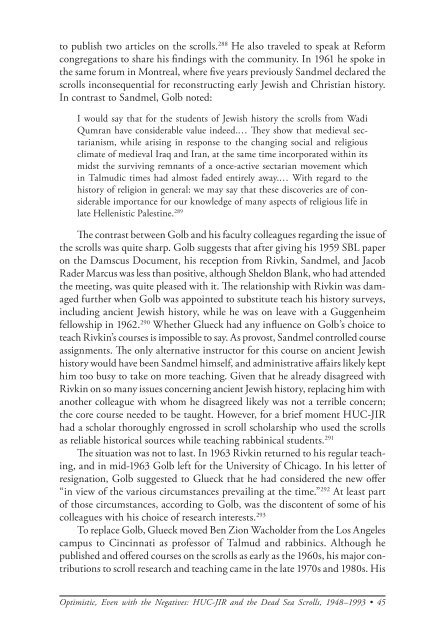The American Jewish Archives Journal, Volume LXI 2009, Number 1
The American Jewish Archives Journal, Volume LXI 2009, Number 1
The American Jewish Archives Journal, Volume LXI 2009, Number 1
You also want an ePaper? Increase the reach of your titles
YUMPU automatically turns print PDFs into web optimized ePapers that Google loves.
to publish two articles on the scrolls. 288 He also traveled to speak at Reform<br />
congregations to share his findings with the community. In 1961 he spoke in<br />
the same forum in Montreal, where five years previously Sandmel declared the<br />
scrolls inconsequential for reconstructing early <strong>Jewish</strong> and Christian history.<br />
In contrast to Sandmel, Golb noted:<br />
I would say that for the students of <strong>Jewish</strong> history the scrolls from Wadi<br />
Qumran have considerable value indeed.… <strong>The</strong>y show that medieval sectarianism,<br />
while arising in response to the changing social and religious<br />
climate of medieval Iraq and Iran, at the same time incorporated within its<br />
midst the surviving remnants of a once-active sectarian movement which<br />
in Talmudic times had almost faded entirely away.… With regard to the<br />
history of religion in general: we may say that these discoveries are of considerable<br />
importance for our knowledge of many aspects of religious life in<br />
late Hellenistic Palestine. 289<br />
<strong>The</strong> contrast between Golb and his faculty colleagues regarding the issue of<br />
the scrolls was quite sharp. Golb suggests that after giving his 1959 SBL paper<br />
on the Damscus Document, his reception from Rivkin, Sandmel, and Jacob<br />
Rader Marcus was less than positive, although Sheldon Blank, who had attended<br />
the meeting, was quite pleased with it. <strong>The</strong> relationship with Rivkin was damaged<br />
further when Golb was appointed to substitute teach his history surveys,<br />
including ancient <strong>Jewish</strong> history, while he was on leave with a Guggenheim<br />
fellowship in 1962. 290 Whether Glueck had any influence on Golb’s choice to<br />
teach Rivkin’s courses is impossible to say. As provost, Sandmel controlled course<br />
assignments. <strong>The</strong> only alternative instructor for this course on ancient <strong>Jewish</strong><br />
history would have been Sandmel himself, and administrative affairs likely kept<br />
him too busy to take on more teaching. Given that he already disagreed with<br />
Rivkin on so many issues concerning ancient <strong>Jewish</strong> history, replacing him with<br />
another colleague with whom he disagreed likely was not a terrible concern;<br />
the core course needed to be taught. However, for a brief moment HUC-JIR<br />
had a scholar thoroughly engrossed in scroll scholarship who used the scrolls<br />
as reliable historical sources while teaching rabbinical students. 291<br />
<strong>The</strong> situation was not to last. In 1963 Rivkin returned to his regular teaching,<br />
and in mid-1963 Golb left for the University of Chicago. In his letter of<br />
resignation, Golb suggested to Glueck that he had considered the new offer<br />
“in view of the various circumstances prevailing at the time.” 292 At least part<br />
of those circumstances, according to Golb, was the discontent of some of his<br />
colleagues with his choice of research interests. 293<br />
To replace Golb, Glueck moved Ben Zion Wacholder from the Los Angeles<br />
campus to Cincinnati as professor of Talmud and rabbinics. Although he<br />
published and offered courses on the scrolls as early as the 1960s, his major contributions<br />
to scroll research and teaching came in the late 1970s and 1980s. His<br />
Optimistic, Even with the Negatives: HUC-JIR and the Dead Sea Scrolls, 1948–1993 • 45

















